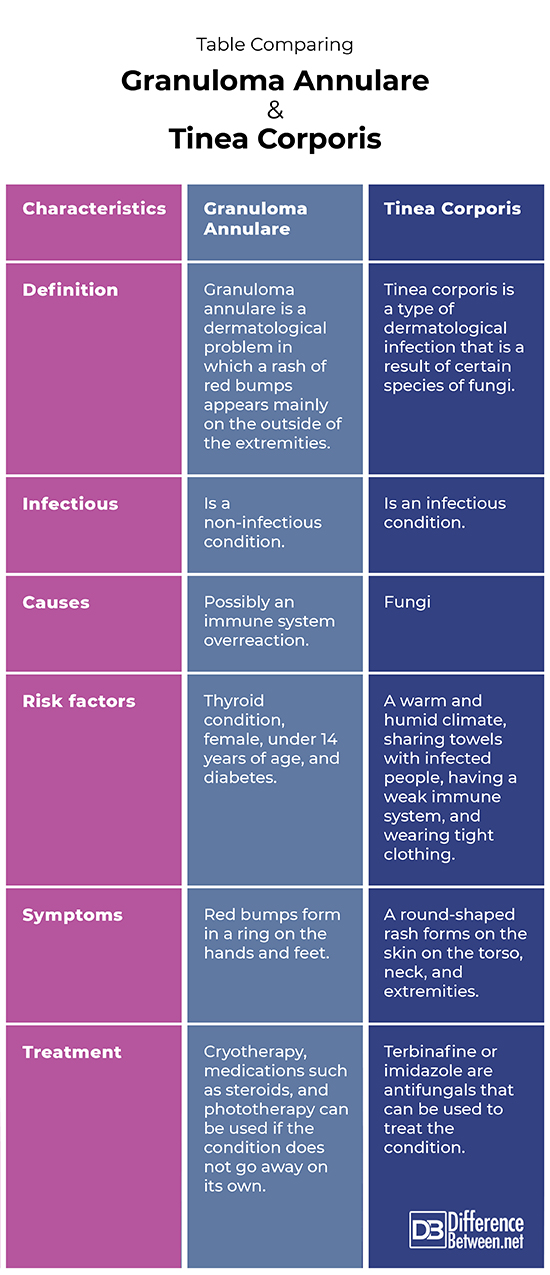Difference Between Granuloma Annulare and Tinea Corporis
Granuloma annulare is a skin condition where you have raised bumps on the extremities. Tinea corporis is a fungus that infects the skin.

What is Granuloma annulare ?
Definition:
Granuloma annulare is a condition of the skin where there are rings of bumps that develop on the extremities.
Causes and risk factors:
The cause of granuloma annulare is believed to be a problem with the immune system or because of hypersensitivity. Risk factors for granuloma annulare include being a diabetic or having a thyroid problem. Females who are younger than 14 years of age are also more prone to developing this skin condition.
Diagnosis:
A skin biopsy is the only sure way to ascertain and diagnose granuloma annulare and to eliminate other potential causes of a skin rash.
Symptoms and complications:
The signs of the condition include red bumps present on the outer surfaces of the feet and hands. There are usually no complications with granuloma annulare and it usually goes away.
Treatment:
You can treat granuloma annulare using cryotherapy, medications like steroids, and phototherapy. Treatment is not always even needed because the skin usually clears up over time.

What is Tinea corporis?
Definition:
Tinea corporis is a fungus infection that infects the body, specifically the skin.
Causes and risk factors:
Tinea corporis, specifically, is caused by fungal organisms, Microsporum and Trichophyton. Risk factors for infection include sharing towels with infected persons, living in a warm, humid climate and wearing tight clothing. You are also at higher risk of this fungal infection if your immune system is weakened.
Diagnosis:
The infection can be diagnosed by a physical exam along with a microscope examination of the skin showing the fungus present in the cells.
Symptoms and complications:
If you have tinea corporis, you will have red round patches on the skin. The rash will occur on the chest, back, neck, and extremities. Complications are rare but can include Majocchi granuloma, in which infection spreads deeper into the skin.
Treatment:
Antifungals are used to treat tinea corporis. These can be given orally or as a cream and can include terbinafine or imidazole.
Difference between Granuloma annulare and Tinea corporis
Definition
Granuloma annulare is a dermatological problem in which a rash of red bumps appears on the outside of the extremities. Tinea corporis is an infection of the skin that is caused by fungal organisms.
Infectious
Granuloma annulare is not due to an infection. Tinea corporis is due to an infection.
Causes
Granuloma annulare is likely caused by an immune system that is overactive. Tinea corporis is caused by infection by fungi.
Risk factors
The risk factors for granuloma annulare include having a thyroid condition, being female, under 14 years of age, and having diabetes. The risk factors for tinea corporis include living in a warm and humid climate, sharing towels with infected people, having a weak immune system, and wearing tight clothing.
Symptoms
The symptoms of granuloma annulare are the presence of red bumps that have a round shape; these occur on the feet and hands. The symptoms of tinea corporis are a round- shaped skin rash that is not limited to the hands and feet.
Treatment
Cryotherapy, medications such as steroids, and phototherapy can be used to treat granuloma annulare but sometimes the condition does go away on its own. Terbinafine or imidazole are antifungals that can be used to treat tinea corporis.
Table comparing Granuloma annulare and Tinea corporis

Summary of Granuloma annulare Vs. Tinea corporis
- Granuloma annulare and tinea corporis both cause ring-like structures to develop on the skin and look quite similar.
- Tinea corporis is caused by an infection with particular species of fungus.
- Granuloma annulare is probably due to a hypersensitivity reaction.
- Granuloma annulare often does resolve after a couple of weeks, but tinea corporis may need antifungal treatments.
FAQ
What is the difference between ringworm and granuloma annulare?
Ringworm is caused by a fungal infection while granuloma annulare is not.
What can be mistaken for granuloma annulare?
It is easy to mistake ringworm for granuloma annulare but the rash in the case of ringworm will itch while the rash of granuloma annulare will not be itchy.
What can be mistaken for tinea corporis?
Psoriasis, impetigo, pityriasis rosea, and seborrheic dermatitis can be mistaken for tinea corporis because all of these are skin conditions that produce a rash. A skin biopsy can help properly diagnose exactly what type of skin problem you have if you do have a rash.
Is tinea corporis annular?
Yes, tinea corporis is annular because the rash that is formed occurs in rings.
Can an antifungal help granuloma annulare?
No, granuloma annulare is not caused by a fungus, so an antifungal is not helpful in treating the problem, besides most of the time, the condition resolves on its own. It is better to use steroid creams to help with the inflammatory response if needed.
Is granuloma annulare caused by fungus?
No, granuloma annulare is not due to fungal infection but rather is likely due to an immune system response.
- Difference Between Rumination and Regurgitation - June 13, 2024
- Difference Between Pyelectasis and Hydronephrosis - June 4, 2024
- Difference Between Cellulitis and Erysipelas - June 1, 2024
Search DifferenceBetween.net :
Leave a Response
References :
[0]Aaron, Denise M. “Tinea Corporis (Body Ringworm)”. Merck Manual, 2021, https://www.msdmanuals.com/professional/dermatologic-disorders/fungal-skin-infections/tinea-corporis-body-ringworm
[1]Benedetii, Julia “Granuloma annulare” ”. Merck Manual, 2022, https://www.msdmanuals.com/professional/dermatologic-disorders/hypersensitivity-and-reactive-skin-disorders/granuloma-annulare
[2]Schmieder, Shawn J., Chelsea D. Harper, and George J. Schmieder. "Granuloma annulare." StatPearls, 2017, https://www.ncbi.nlm.nih.gov/books/NBK459377/
